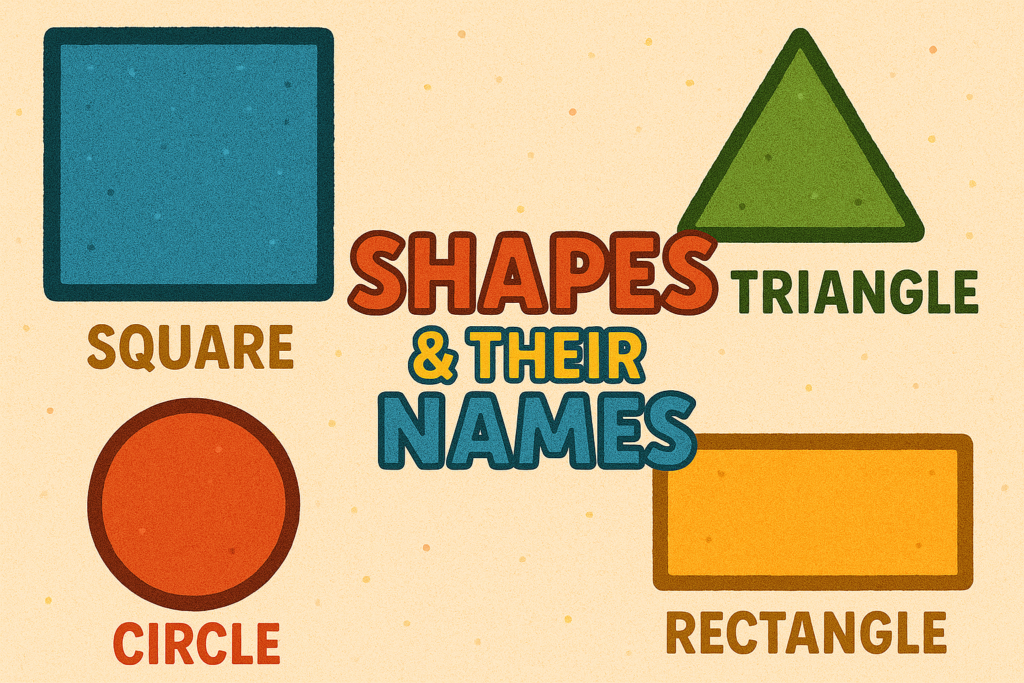Introduction: Discovering the Shapes Around Us
Shapes are everywhere—from the sun in the sky to the sandwich on your plate. Recognizing them isn’t just fun; it’s one of the first steps in early learning. Understanding shapes name with pictures helps kids develop observation skills, memory, and problem-solving abilities.
At leading nursery schools in Bangalore, shape learning begins early through hands-on activities, visual aids, and outdoor discovery. Let’s explore shapes in a way your child will never forget.
Why Shapes Matter in Early Learning
Shapes do more than just teach children to draw or sort. They help develop:
- Visual recognition and spatial awareness
- Pre-math and geometry skills
- Language development through naming and describing
- Creativity and logical thinking
That’s why top pre schools in Bangalore focus on shape learning through both structured and play-based activities.
Shapes Name with Pictures (Plus Pronunciation & Fun Riddles)
1. Circle
Pronounced: Sir-kuhl
Riddle: I’m round and never end, I roll and spin and love to bend.
Real-life examples: Clock, coin, ring
2. Square
Pronounced: Skwair
Riddle: I have four equal sides, straight and proud. You’ll find me in a checkerboard crowd.
Real-life examples: Windows, tiles, post-it notes
3. Rectangle
Pronounced: Rek-tang-guhl
Riddle: I look like a stretched square, longer on two sides but still fair.
Real-life examples: Doors, books, smartphones
4. Triangle
Pronounced: Try-ang-guhl
Riddle: I have three sides, not one more. Look at a pizza slice—you’ve seen me before!
Real-life examples: Traffic signs, nachos, mountains
5. Oval
Pronounced: Oh-vuhl
Riddle: I’m a circle in a stretch, like an egg you might fetch.
Real-life examples: Eggs, mirrors, balloons
6. Diamond (Rhombus)
Pronounced: Dai-muhnd
Riddle: Like a tilted square I shine, in a kite or a road sign.
Real-life examples: Playing cards, kite shape
7. Star
Pronounced: Stahr
Riddle: I twinkle up in the night sky, count my points and you’ll know why.
Real-life examples: Stars on flags, holiday decor
8. Heart
Pronounced: Haart
Riddle: I say “I love you” without a sound. My curvy top and point are round.
Real-life examples: Stickers, cards, emojis
Shape Learning Through Art Activities
Children remember best when they create. Try these:
Shape Collage Creatures:
Cut out colored shapes and let your child build animals or vehicles. A square can be a body, triangles for ears or wheels.
Stamp and Paint Shapes:
Use shape-cut sponges dipped in paint to make beautiful patterns.
Build-a-Robot Challenge:
Give your child various paper shapes and ask them to make their own robot using rectangles for arms, squares for the body, circles for eyes, and more.
Kite Craft with Diamonds:
Make your own kite using a diamond shape, then fly it outdoors for added excitement. This pairs beautifully with the importance of outdoor play.
Take Shapes Outdoors
Turn a walk into a shape hunt:
- Spot rectangles in windows
- Find triangles in road signs
- Draw circles and squares with sidewalk chalk
Top nursery schools in Bangalore blend outdoor movement with shape discovery to keep learning active and memorable.
How Shapes Help Children in School
Understanding shapes is part of early geometry, and helps with:
- Problem-solving in math
- Drawing and writing letter forms
- Sorting and classifying skills in science
- Understanding spatial directions like “above,” “below,” “beside”
This is why many pre schools in Bangalore build foundational shape recognition into their curriculum right from the toddler stage.
Conclusion: Shapes Are Just the Beginning
From a child’s first circle to spotting triangles in the sky, shapes name with pictures make learning fun, visual, and full of meaning. Shapes help children make sense of the world, unlock language and math skills, and ignite creativity through art and play.
Let your child touch, draw, craft, and spot shapes every day—they’ll be learning without even realizing it.
FAQs
By age 2–3, children can begin recognizing basic shapes like circles, squares, and triangles.
Use toys, games, shape scavenger hunts, drawing, and crafts to make learning hands-on.
Pronunciation builds language skills and confidence. Saying the names clearly supports early literacy.
Yes! Riddles make learning playful, improve memory, and get kids thinking creatively.
Absolutely. Finding shapes outside adds movement and excitement to learning.

